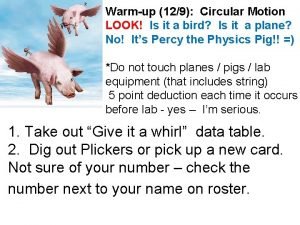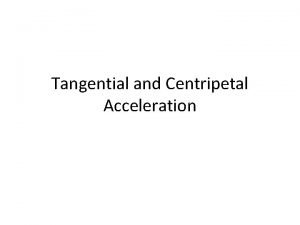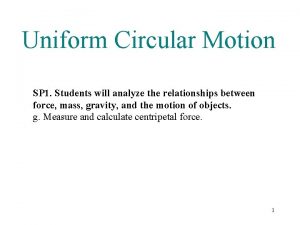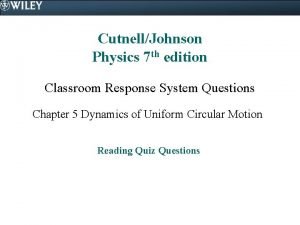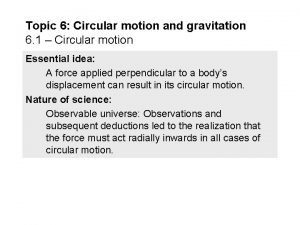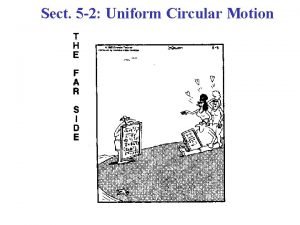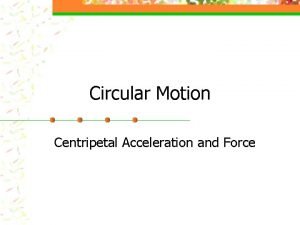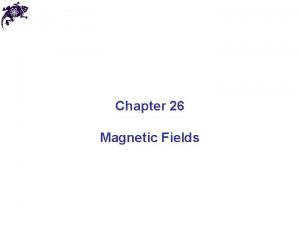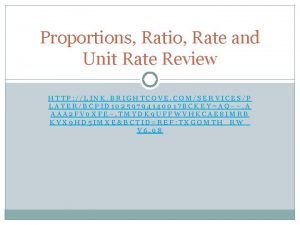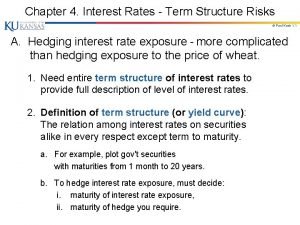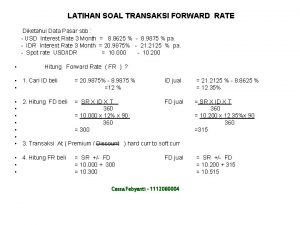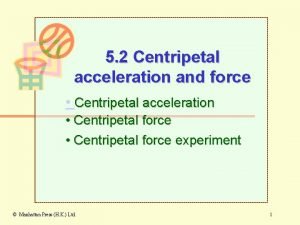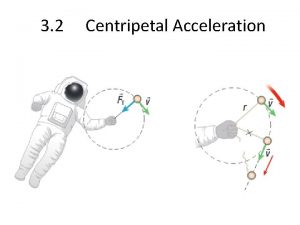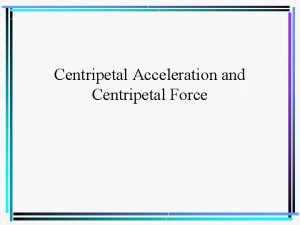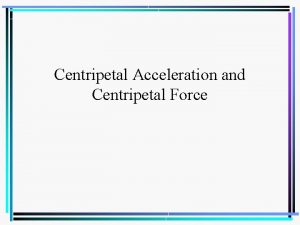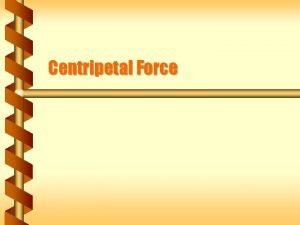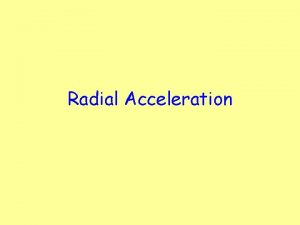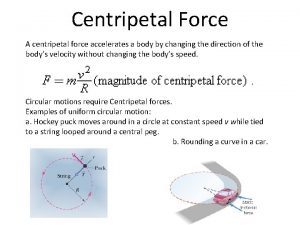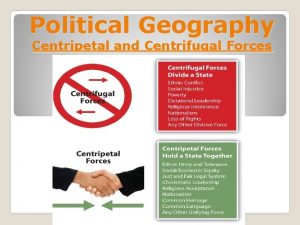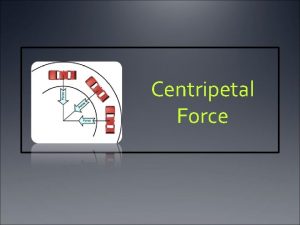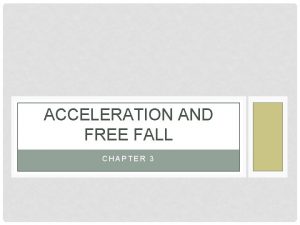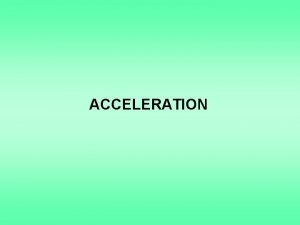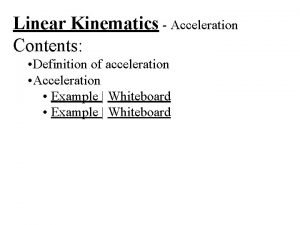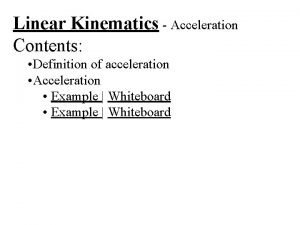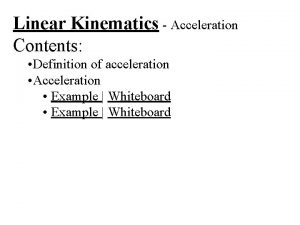Centripetal Acceleration Centripetal acceleration is the rate of





























- Slides: 29

Centripetal Acceleration • Centripetal acceleration is the rate of change in velocity of an object that is associated with the change in direction of the velocity. – Centripetal acceleration is always perpendicular to the velocity. – Centripetal acceleration always points toward the center of the curve.

Centripetal Forces • The centripetal force may be due to one or more individual forces, such as a normal force and/or a force due to friction. .

• The friction between the tires and road produces the centripetal acceleration on a level curve.

On a banked circular track, assuming no friction on the surface, will the ball be able to make a circular motion with constant speed? A). Yes. B). No. friction is absolutely needed.

v The normal force can be separated into a vertical component and a ho v The horizontal component of the normal force is the centripetal force when there’s no friction in order to keep the object (car) on the circular track.

Quiz: A Car moves along a banked circular track (θ=30 o) and experience a normal force of 1000 kg. How large is the vertical component (Fv) and horizontal component (Fh)? A). Fv = 866 kg, Fh = 500 kg. B). Fv = 500 kg, Fh = 866 kg. C). Fv = 500 kg, Fh = 500 kg D). Fv = 866 kg, Fh = 134 kg.

Vertical circles N v W = mg mg – N = mv 2/r • If v = 0 then N = mg g + is always toward the center of the circle • As v increases N becomes smaller • When v 2/r = g the car becomes weightless. 10/24/2021 Ferris wheel At the bottom N - mg = mv 2/r At the top Mg – N = mv 2/r Physics 214 Fall 2010 7

A floating dog http: //www. digitaljournal. com/image/71076 https: //www. youtube. com/watch? v=6 Nv. BGb 5 lf 78 8

Ch 5 CP 2 A Ferris wheel with radius 12 m makes one complete rotation every 8 seconds. What speed do riders move at? A). B). C). D). 56. 52 m/s 9. 42 m/s 18. 84 m/s 4. 71 m/s Fcent 2 m r=1 S = d/t = 2 r/t = 2 (12 m)/8 s = 9. 42 m/s 9

Ch 5 CP 2 A Ferris wheel with radius 12 m makes one complete rotation every 8 seconds. What is the magnitude of their centripetal acceleration? A). 7. 40 m/s 2 B). 9. 40 m/s 2 C). 3. 70 m/s 2 D). 14. 80 m/s 2 Fcent acent = v 2/r = s 2/r = (9. 42 m/s)2/12 m = 7. 40 m/s 2 2 m r=1 10

Ch 5 CP 2 A Ferris wheel with radius 12 m makes one complete rotation every 8 seconds. For a 40 kg rider, what is magnitude of centripetal force to keep him moving in a circle? Is his true weight large enough to provide this centripetal force at the top of the cycle? A). 396 N, weight is large enough. B). 1028 N, weight is large enough C). 200 N, weight is large enough D). 296 N, weight is large enough E). 296 N, weight is NOT large enough Fcent 2 m r=1 Fcent = m v 2/r = m acent = (40 kg)(7. 40 m/s 2) = 296 N W = mg = (40 kg)(9. 8 m/s 2) = 392 N Yes, his weight is larger than the centripetal force required. 11

Ch 5 CP 2 A Ferris wheel with radius 12 m makes one complete rotation every 8 seconds. What is the magnitude of the normal force exerted by the seat on the rider at the top? A). 100 N B). 96 N C). 90 N D). 50 N E). 48 N Fcent W – Nf = 296 2 m r=1 N = 96 newtons 12

Ch 5 CP 2 A Ferris wheel with radius 12 m makes one complete rotation every 8 seconds. What would happen if the Ferris wheel is going so fast the weight of the rider is not sufficient to provide the centripetal force at the top? Note: there’s no safe belt. A) rider is ejected B) Rider remain on seat Fcent 2 m r=1 13

Ch 5 CP 4 A passenger in a rollover accident turns through a radius of 3. 0 m in the seat of the vehicle making a complete turn in 1 sec. what is rotational speed of passenger? A). 38 m/s B). 22 m/s C). 19 m/s D). 11 m/s E). 125. 3 m/s s = d/t = 2 (3. 0 m)/1 = 19 m/s 3 m 14

Quiz A passenger in a rollover accident turns through a radius of 3. 0 m in the seat of the vehicle making a complete turn in 1 sec. What is centripetal acceleration? Compare it to gravity (g = 9. 8 m/s 2) A). 118 m/s 2 B). 128 m/s 2 C). 138 m/s 2 D). 108 m/s 2 E). 98 m/s 2 3 m 15

Ch 5 CP 4 A passenger in a rollover accident turns through a radius of 3. 0 m in the seat of the vehicle making a complete turn in 1 sec. Passenger has mass = 60 kg, what is centripetal force required to produce the acceleration? Compare it to passengers weight. A). 10000 N B). 1352 N C). 7080 N D). 1159. 3 N E). 205 N m/s 2) F = ma = (60 kg)(118 = 7080 N F = ma = m (13 X 9. 8 m/s 2) = 13 mg = 13 weight 3 m 16

How Tough is 13 g? What’s shown in the video is < 10 g. 17

Planetary Motion • The ancient Greeks believed the sun, moon, stars and planets all revolved around the Earth. – This is called a geocentric view (Earth-centered) of the universe. – This view matched their observations of the sky, with the exception of the puzzling motion of the wandering planets. 1 In 4 Americans Thinks The Sun Goes Around The Earth, Survey Says https: //www. npr. org/sections/thetwo-way/2014/02/14/277058739/1 -in-4 -americans-think-the-sun-goes-around-theearth-survey-says 18

Kepler’s First Law of Planetary Motion v. Tycho’s assistant, Kepler, analyzed all that careful data. v. Kepler was able to show that the orbits of the planets around the sun are ellipses, with the sun at one focus. v. This is Kepler’s first law of planetary motion. 19

Kepler’s Second Law of Planetary Motion vplanets move faster when nearer to the sun, the radius line for each planet sweeps out equal areas in equal times. v. The two blue sections each cover the same span of time and have equal area. 20

Kepler’s Third Law of Planetary Motion v. The period (T) of an orbit is the time it takes for one complete cycle around the sun. v. The cube of the average radius (r) about the sun is proportional to the square of the period of the orbit. 21

Newton’s Law of Universal Gravitation http: //www. physics. purdue. edu/class/applets/Newtons. Cannon/n ewtmtn. html • Newton recognized the similarity between the motion of a projectile on Earth and the orbit of the moon. • If a projectile is fired with enough velocity, it could fall towards Earth but never reach the surface. 22

Newton’s Law of Universal Gravitation • Newton was able to explain Kepler’s 1 st and 3 rd laws by assuming the gravitational force between planets and the sun falls off as the inverse square of the distance. • Newton’s law of universal gravitation says the gravitational force between two objects is proportional to the mass of each object, and inversely proportional to the square of the distance between the two objects. • G is the Universal gravitational constant G, which was measured by Cavendish after more than 100 years • G = 6. 67 x 10 -11 N. m 2/kg 2. 23

The gravitational force is attractive and acts along the line joining the center of the two masses. It obeys Newton’s third law of motion. 24

Using Newton’s Gravitational Law to derive Kepler’s 3 rd Law • T 2/r 3 = 4π2/GMs 25

Ch 5 E 14 The acceleration of gravity at the surface of the moon is about 1/6 that at the surface of the Earth (9. 8 m/s 2). What is the weight of an astronaut standing on the moon whose weight on earth is 180 lb? A). 30 lb B). 180 lb. C). 15 lb. D). 200 lb E). 215 lb. 26

Ch 5 E 14 The acceleration of gravity at the surface of the moon is about 1/6 that at the surface of the Earth (9. 8 m/s 2). What is the weight of an astronaut standing on the moon whose weight on earth is 180 lb? Wearth = m gearth = 180 lb Wmoon = m gmoon = 1/6 gearth Wmoon = m 1/6 gearth = 1/6 m gearth = 1/6 (180 lb) 27

Moon and tides anim 0012. mov • Tides are dominantly due to the gravitational force exerted by the moon. Since the earth and moon are rotating this effect also plays a role. The moon is locked to the earth so that we always see the same face. Because of the friction generated by tides the moon is losing energy and moving away from the earth. http: //www. sfgate. com/getoutside/1996/jun/tides. html 28

Quiz: Three equal masses are located as shown. What is the direction of the total force acting on m 2? a) b) c) d) To the left. To the right. The forces cancel such that the total force is zero. It is impossible to determine from the figure. 29
 Centripetal acceleration formula
Centripetal acceleration formula Radial acceleration definition
Radial acceleration definition Centripetal acceleration tangential acceleration
Centripetal acceleration tangential acceleration Dynamics of uniform circular motion
Dynamics of uniform circular motion Tangential speed
Tangential speed Centripetal acceleration is a scalar quantity.
Centripetal acceleration is a scalar quantity. Centripetal acceleration
Centripetal acceleration Centripetal acceleration physics classroom
Centripetal acceleration physics classroom 6-1 centripetal acceleration and force
6-1 centripetal acceleration and force Circular motion constant speed
Circular motion constant speed Missy's favorite ride at the topsfield fair is the rotor
Missy's favorite ride at the topsfield fair is the rotor 6-1 centripetal acceleration and force
6-1 centripetal acceleration and force Centripetal acceleration unit
Centripetal acceleration unit Spiral helix
Spiral helix Linear acceleration vs tangential acceleration
Linear acceleration vs tangential acceleration Angular quantities
Angular quantities Unit rate proportions
Unit rate proportions Cap rate interest rate relationship
Cap rate interest rate relationship Real exchange rate formula
Real exchange rate formula Nominal v. real interest rates
Nominal v. real interest rates Option adjusted spread
Option adjusted spread Growth analysis
Growth analysis 1 year forward rate formula
1 year forward rate formula Contoh soal spot rate dan forward rate
Contoh soal spot rate dan forward rate Thể thơ truyền thống
Thể thơ truyền thống Số nguyên tố là gì
Số nguyên tố là gì Các châu lục và đại dương trên thế giới
Các châu lục và đại dương trên thế giới Tia chieu sa te
Tia chieu sa te Vẽ hình chiếu vuông góc của vật thể sau
Vẽ hình chiếu vuông góc của vật thể sau Sơ đồ cơ thể người
Sơ đồ cơ thể người



